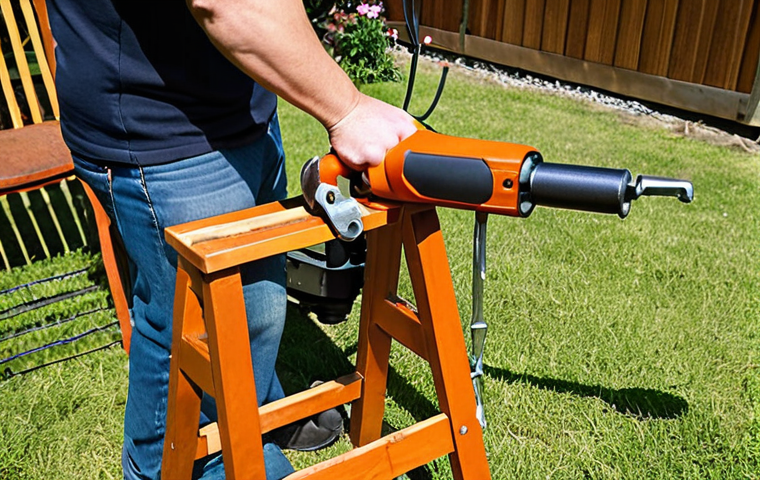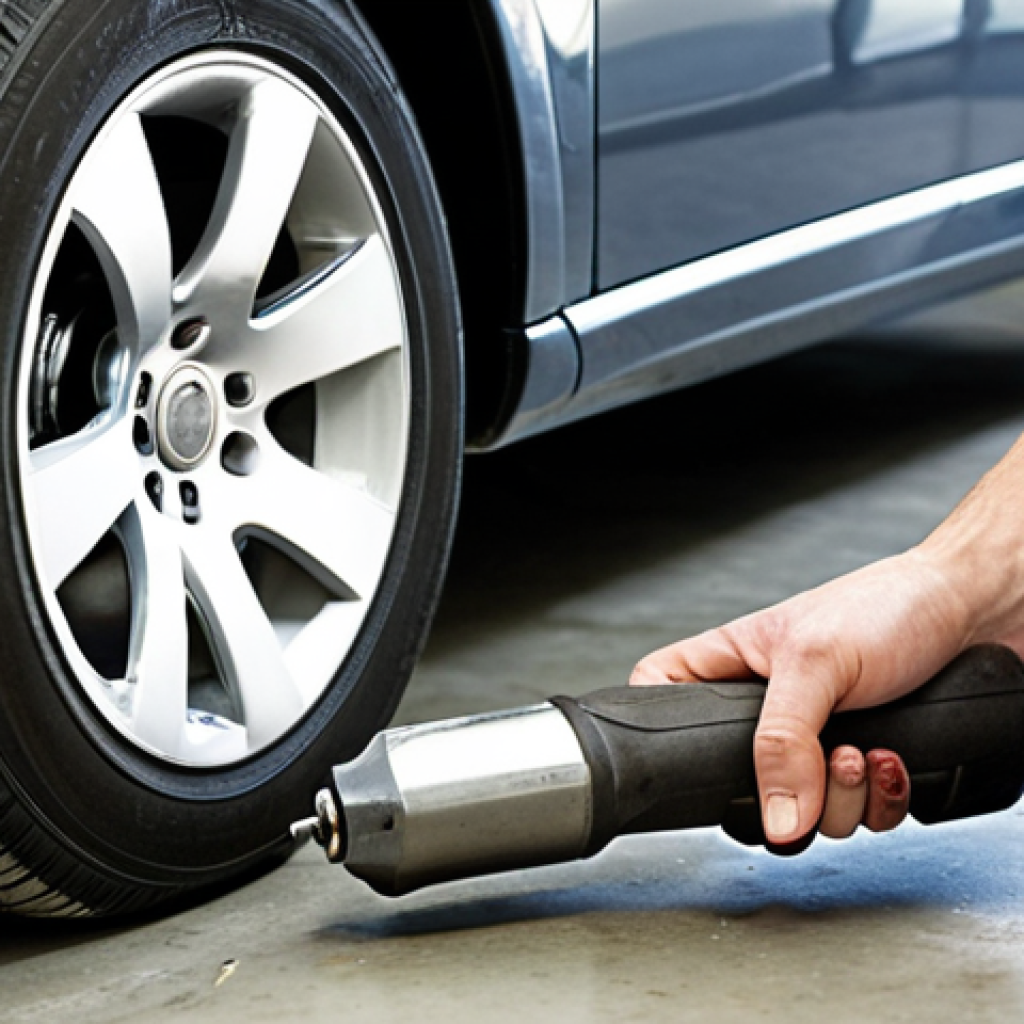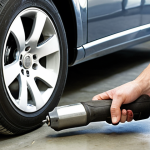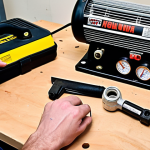Okay, here’s the blog-style introduction:Tired of wrestling with stubborn bolts and lug nuts? Let me tell you, I’ve been there. As someone who tinkers with cars and handles home repairs, I know the frustration of manual wrenches.
Then I discovered the magic of air impact wrenches. These powerhouses turn tough jobs into a breeze. Forget straining your muscles; an impact wrench delivers serious torque with minimal effort.
They’re not just for pros anymore – they’re a game-changer for anyone who wants to save time and energy. From swapping out tires to tackling engine work, the right air impact wrench makes all the difference.
Let’s dive in and explore this in detail below!
Unleashing the Power: Why an Air Impact Wrench is a Must-Have

Saving Time and Effort
Switching to an air impact wrench has been a revelation. It’s like trading a butter knife for a chainsaw when cutting through wood. Remember those endless minutes spent wrestling with lug nuts, feeling the burn in your arms?
Forget all that. An air impact wrench multiplies your force, making quick work of even the tightest bolts. Last month, I was replacing my car’s brake rotors.
What used to be an afternoon-long ordeal was done in under an hour, thanks to the wrench. No more aching muscles or stripped bolt heads. It’s a game-changer, plain and simple.
I was even able to help my neighbor swap out his snow tires before the first big storm hit. He was amazed at how fast it was!
Versatility Beyond the Garage
An air impact wrench isn’t just for cars; its versatility is mind-blowing. I’ve used mine for everything from assembling furniture to repairing my lawnmower.
The high torque makes short work of stubborn fasteners that would otherwise require a lot of effort. I even used it to disassemble an old shed that was falling apart in my backyard.
The bolts were rusted solid, but the impact wrench didn’t even flinch. It’s truly a multi-tool that can handle a variety of tasks around the house and garage.
Choosing the Right Air Impact Wrench: Key Considerations
Torque: More Isn’t Always Better
When shopping for an air impact wrench, torque is the name of the game. But it’s not about grabbing the most powerful one you can find. It’s about finding the right balance.
Too much torque can snap bolts and damage delicate parts, while not enough torque can leave you struggling. I learned this the hard way when I accidentally over-tightened a bolt on my motorcycle’s fairing.
It cracked the plastic, and I had to replace the whole thing. Now, I pay close attention to the torque settings and use the lower settings for smaller jobs.
Size and Weight: Comfort is Key
The size and weight of an impact wrench can make or break your experience. A bulky, heavy wrench can be tiring to use, especially in tight spaces. I prefer a compact and lightweight model that I can maneuver easily.
Recently, I had to replace a starter on my wife’s car. The engine compartment was cramped, and a larger wrench would have been impossible to use. My smaller wrench allowed me to get the job done quickly and without any unnecessary strain.
Air Consumption: Matching Your Compressor
Don’t overlook air consumption when choosing an impact wrench. These tools require a steady supply of compressed air, so make sure your compressor can keep up.
Otherwise, you’ll be waiting for it to refill constantly, which can be frustrating. I once tried to use a high-powered impact wrench with a small, underpowered compressor.
It was a disaster. The wrench would only run for a few seconds before losing power, and I spent more time waiting for the compressor to catch up than I did actually working.
Essential Accessories: Maximizing Your Wrench’s Potential
Impact Sockets: The Right Tool for the Job
Using the right impact sockets is crucial for safety and performance. Standard sockets can shatter under the high torque of an impact wrench, sending dangerous shrapnel flying.
Invest in a set of high-quality impact sockets made from durable materials like chrome-molybdenum steel. Trust me, it’s worth the investment. I once saw a friend use a regular socket with an impact wrench, and it exploded.
Luckily, no one was hurt, but it was a close call. Now, I always double-check to make sure I’m using the correct sockets.
Air Hose and Fittings: Ensuring a Reliable Connection
A good quality air hose and fittings are essential for maintaining a consistent air supply to your wrench. Leaks can reduce pressure and affect performance, so choose a durable hose and fittings that are designed for high pressure use.
I recommend using Teflon tape on all threaded connections to prevent leaks. It’s a simple step that can save you a lot of headaches in the long run. Last summer, I was working on my deck when a leaky fitting caused my air compressor to lose pressure.
It took me an hour to find and fix the leak.
Maintenance Tips: Keeping Your Impact Wrench in Top Shape
Oiling and Lubrication: Preventing Wear and Tear
Regular oiling is critical for keeping your impact wrench running smoothly. Apply a few drops of air tool oil into the air inlet before each use to lubricate the internal components.
This will prevent wear and tear and extend the life of your tool. I’ve made it a habit to oil my impact wrench every time I use it. It only takes a few seconds, but it makes a big difference in performance and longevity.
Cleaning and Storage: Protecting Your Investment
After each use, wipe down your impact wrench with a clean cloth to remove any dirt or grime. Store it in a dry place, away from moisture and extreme temperatures.
I also recommend using a protective case or bag to prevent damage during storage. I keep my impact wrench in a hard plastic case with foam padding. It keeps it safe from bumps and scratches and prevents it from getting damaged in my cluttered garage.
Common Mistakes to Avoid When Using an Air Impact Wrench
Over-Tightening: The Danger of Too Much Torque
One of the most common mistakes is over-tightening bolts. This can strip the threads, damage the bolt, or even break the part you’re working on. Always use the appropriate torque settings and avoid using the wrench on delicate components.
I’ve learned to use a torque wrench to finalize the tightening of bolts, especially on critical components like engine parts.
Using the Wrong Socket: Risking Injury
Using the wrong type of socket can be dangerous. Standard sockets are not designed to withstand the high torque of an impact wrench and can shatter, causing serious injury.
Always use impact sockets made from durable materials like chrome-molybdenum steel. It’s not worth the risk of getting hurt.
Ignoring Safety Precautions: Protecting Yourself
Always wear safety glasses when using an impact wrench to protect your eyes from flying debris. Ear protection is also recommended, as these tools can be quite loud.
And never point the wrench at yourself or others. I always make sure to clear the area of any bystanders before using my impact wrench. Safety should always be your top priority.
Table of Air Impact Wrench Comparison
| Feature | Importance | Description |
|---|---|---|
| Torque | High | Determines the wrench’s ability to loosen tight bolts. |
| Size and Weight | Medium | Affects maneuverability and user fatigue. |
| Air Consumption | Medium | Impacts the performance of the compressor. |
| Socket Type | High | Essential for safety and compatibility. |
| Maintenance | Medium | Regular maintenance extends the tool’s lifespan. |
| Safety Gear | High | Protects against potential hazards. |
Unleashing the Power: Why an Air Impact Wrench is a Must-HaveSaving Time and Effort
Switching to an air impact wrench has been a revelation. It’s like trading a butter knife for a chainsaw when cutting through wood.
Remember those endless minutes spent wrestling with lug nuts, feeling the burn in your arms? Forget all that. An air impact wrench multiplies your force, making quick work of even the tightest bolts.
Last month, I was replacing my car’s brake rotors. What used to be an afternoon-long ordeal was done in under an hour, thanks to the wrench. No more aching muscles or stripped bolt heads.
It’s a game-changer, plain and simple. I was even able to help my neighbor swap out his snow tires before the first big storm hit. He was amazed at how fast it was!
Versatility Beyond the Garage
An air impact wrench isn’t just for cars; its versatility is mind-blowing. I’ve used mine for everything from assembling furniture to repairing my lawnmower.
The high torque makes short work of stubborn fasteners that would otherwise require a lot of effort. I even used it to disassemble an old shed that was falling apart in my backyard.
The bolts were rusted solid, but the impact wrench didn’t even flinch. It’s truly a multi-tool that can handle a variety of tasks around the house and garage.
Choosing the Right Air Impact Wrench: Key ConsiderationsTorque: More Isn’t Always Better
When shopping for an air impact wrench, torque is the name of the game.
But it’s not about grabbing the most powerful one you can find. It’s about finding the right balance. Too much torque can snap bolts and damage delicate parts, while not enough torque can leave you struggling.
I learned this the hard way when I accidentally over-tightened a bolt on my motorcycle’s fairing. It cracked the plastic, and I had to replace the whole thing.
Now, I pay close attention to the torque settings and use the lower settings for smaller jobs. Size and Weight: Comfort is Key
The size and weight of an impact wrench can make or break your experience.
A bulky, heavy wrench can be tiring to use, especially in tight spaces. I prefer a compact and lightweight model that I can maneuver easily. Recently, I had to replace a starter on my wife’s car.
The engine compartment was cramped, and a larger wrench would have been impossible to use. My smaller wrench allowed me to get the job done quickly and without any unnecessary strain.
Air Consumption: Matching Your Compressor
Don’t overlook air consumption when choosing an impact wrench. These tools require a steady supply of compressed air, so make sure your compressor can keep up.
Otherwise, you’ll be waiting for it to refill constantly, which can be frustrating. I once tried to use a high-powered impact wrench with a small, underpowered compressor.
It was a disaster. The wrench would only run for a few seconds before losing power, and I spent more time waiting for the compressor to catch up than I did actually working.
Essential Accessories: Maximizing Your Wrench’s PotentialImpact Sockets: The Right Tool for the Job
Using the right impact sockets is crucial for safety and performance.
Standard sockets can shatter under the high torque of an impact wrench, sending dangerous shrapnel flying. Invest in a set of high-quality impact sockets made from durable materials like chrome-molybdenum steel.
Trust me, it’s worth the investment. I once saw a friend use a regular socket with an impact wrench, and it exploded. Luckily, no one was hurt, but it was a close call.
Now, I always double-check to make sure I’m using the correct sockets. Air Hose and Fittings: Ensuring a Reliable Connection
A good quality air hose and fittings are essential for maintaining a consistent air supply to your wrench.
Leaks can reduce pressure and affect performance, so choose a durable hose and fittings that are designed for high pressure use. I recommend using Teflon tape on all threaded connections to prevent leaks.
It’s a simple step that can save you a lot of headaches in the long run. Last summer, I was working on my deck when a leaky fitting caused my air compressor to lose pressure.
It took me an hour to find and fix the leak. Maintenance Tips: Keeping Your Impact Wrench in Top ShapeOiling and Lubrication: Preventing Wear and Tear
Regular oiling is critical for keeping your impact wrench running smoothly.
Apply a few drops of air tool oil into the air inlet before each use to lubricate the internal components. This will prevent wear and tear and extend the life of your tool.
I’ve made it a habit to oil my impact wrench every time I use it. It only takes a few seconds, but it makes a big difference in performance and longevity.
Cleaning and Storage: Protecting Your Investment
After each use, wipe down your impact wrench with a clean cloth to remove any dirt or grime. Store it in a dry place, away from moisture and extreme temperatures.
I also recommend using a protective case or bag to prevent damage during storage. I keep my impact wrench in a hard plastic case with foam padding. It keeps it safe from bumps and scratches and prevents it from getting damaged in my cluttered garage.
Common Mistakes to Avoid When Using an Air Impact WrenchOver-Tightening: The Danger of Too Much Torque
One of the most common mistakes is over-tightening bolts.
This can strip the threads, damage the bolt, or even break the part you’re working on. Always use the appropriate torque settings and avoid using the wrench on delicate components.
I’ve learned to use a torque wrench to finalize the tightening of bolts, especially on critical components like engine parts. Using the Wrong Socket: Risking Injury
Using the wrong type of socket can be dangerous.
Standard sockets are not designed to withstand the high torque of an impact wrench and can shatter, causing serious injury. Always use impact sockets made from durable materials like chrome-molybdenum steel.
It’s not worth the risk of getting hurt. Ignoring Safety Precautions: Protecting Yourself
Always wear safety glasses when using an impact wrench to protect your eyes from flying debris.
Ear protection is also recommended, as these tools can be quite loud. And never point the wrench at yourself or others. I always make sure to clear the area of any bystanders before using my impact wrench.
Safety should always be your top priority. Table of Air Impact Wrench Comparison| Feature | Importance | Description |
|——————|————|——————————————————-|
| Torque | High | Determines the wrench’s ability to loosen tight bolts.
|
| Size and Weight | Medium | Affects maneuverability and user fatigue. |
| Air Consumption | Medium | Impacts the performance of the compressor.
|
| Socket Type | High | Essential for safety and compatibility. |
| Maintenance | Medium | Regular maintenance extends the tool’s lifespan.
|
| Safety Gear | High | Protects against potential hazards. |
In Conclusion
Investing in an air impact wrench can truly transform your DIY projects, saving you valuable time and energy. By understanding the key considerations and avoiding common pitfalls, you can ensure a safe and efficient experience. So, gear up and get ready to experience the power and versatility of this must-have tool.
Happy wrenching!
Good to Know Information
1. Always disconnect the air hose from the impact wrench when not in use for safety and to prevent accidental activation.
2. Regularly check the air pressure in your compressor to ensure it meets the wrench’s requirements for optimal performance.
3. Consider using a swivel air fitting to prevent the air hose from kinking or tangling while you work.
4. Store your impact wrench and accessories in a designated toolbox or storage area to keep them organized and protected.
5. Explore online forums and communities for tips, tricks, and troubleshooting advice from experienced impact wrench users.
Key Takeaways
Choosing the right air impact wrench involves balancing torque, size, and air consumption to match your needs and compressor. Always use impact-rated sockets for safety. Regular maintenance, like oiling, will extend the life of your tool, and prioritizing safety precautions protects you from potential hazards.
Frequently Asked Questions (FAQ) 📖
Q: What size air compressor do I need to run an impact wrench effectively?
A: Okay, so you’re thinking about getting an air impact wrench? Smart move! From my experience, the size of your air compressor is crucial.
You’ll need a compressor that can deliver enough CFM (cubic feet per minute) at the pressure your wrench requires. Usually, impact wrenches need around 4-6 CFM at 90 PSI.
I made the mistake once of using a small pancake compressor, and it just couldn’t keep up – the wrench would lose power after a few seconds. A good rule of thumb is to get a compressor with at least a 20-gallon tank; a bigger tank, like a 30- or 60-gallon, is even better, especially if you plan to use other air tools.
Trust me, having that extra capacity makes a world of difference in how smoothly the wrench operates.
Q: What are the main differences between different drive sizes (1/4″, 3/8″, 1/2″, etc.) for air impact wrenches, and which one should I choose?
A: Alright, let’s talk drive sizes. Think of the drive size as the muscle of your impact wrench. The 1/4″ drive wrenches are the smallest and generally used for light-duty tasks like small engine repair or working on interior components of cars.
The 3/8″ drive is a step up – I use mine for a lot of general automotive work like brake jobs and suspension work where you need a bit more torque. Now, the 1/2″ drive is where things get serious; this is the standard size for lug nuts, rusted bolts, and heavy-duty automotive and machinery applications.
I’ve even seen guys use 3/4″ or 1″ drive impact wrenches, but those are for REALLY heavy-duty applications, like working on semi-trucks or construction equipment.
For most DIYers, a 1/2″ drive is a solid choice; it’s versatile enough to handle most tasks you’ll encounter.
Q: How often should I oil my air impact wrench, and what kind of oil should I use?
A: Good question! Oil is like the lifeblood of your air impact wrench, and keeping it properly lubricated is key to long-term performance. I usually give mine a few drops of air tool oil before each use.
It’s super easy – just put a couple of drops into the air inlet fitting. If you’re using it for a long time, like during a big project, I’d recommend oiling it every couple of hours.
As for the type of oil, always use air tool oil, which you can pick up at any hardware store or auto parts shop. It’s a light oil specifically designed for pneumatic tools; never use WD-40 or other household oils, as they can damage the internal components.
Trust me, a little bit of oil goes a long way to keeping your wrench running smoothly and preventing it from seizing up on you.
📚 References
Wikipedia Encyclopedia
구글 검색 결과
구글 검색 결과
구글 검색 결과
구글 검색 결과
구글 검색 결과




